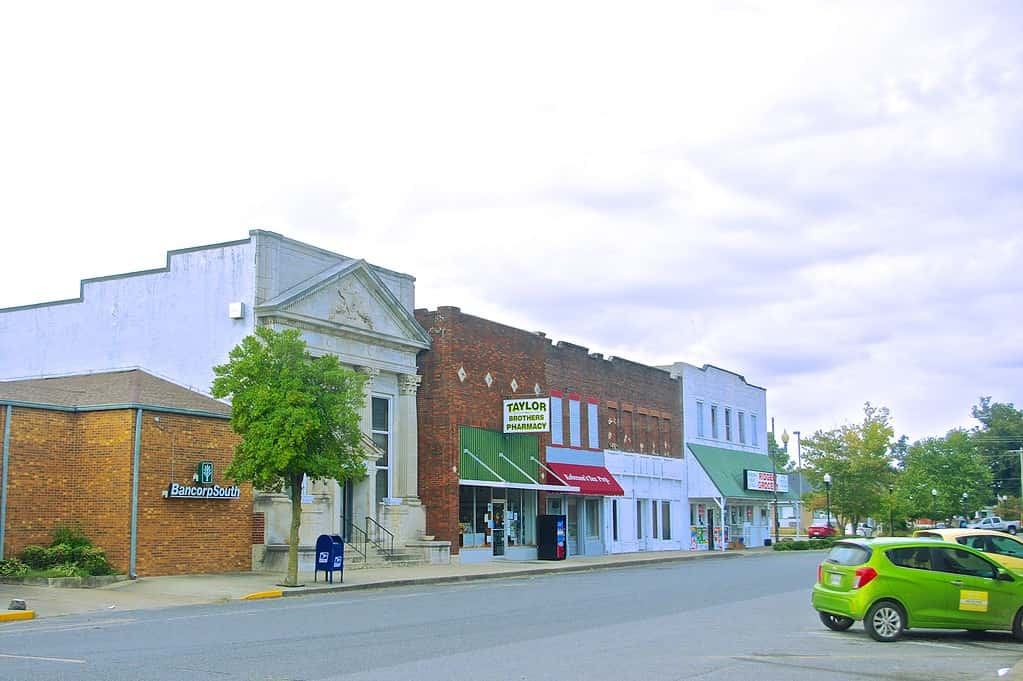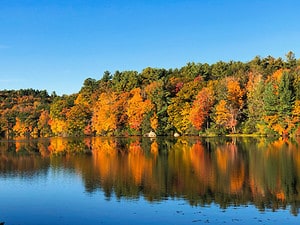The United States Geological Survey estimates that there are over 500,000 detectable earthquakes a year. That may seem like a scary number, but only a small percentage of those quakes cause recordable damage. Still, for the residents of areas that experience severe earthquakes, any number is too high. Seismologists study earthquakes and their waves, but they cannot predict them, nor do they think they will be able to do so any time soon. This makes the prospect of an earthquake a terrifying one, and one community in Tennessee is at especially high risk in comparison with the rest of the state. Before we talk about this town, let’s talk about the seismic risk it faces.
What is an Earthquake?

Cracked roads are one of many consequences of earthquakes and their aftershocks.
©MD_Photography/Shutterstock.com
An earthquake is a sudden shaking of the earth’s surface, caused by the shifting of tectonic plates. Let’s be more specific. The Lithosphere – the outer layer of the earth, also known as the crust – is a collection of tectonic plates. These plates are constantly shifting and in motion, drifting on top of a molten layer of earth that rests beneath them. The stress of this constant movement creates tension in the earth’s surface, creating pressure that leads to the creation of faults. A fault is a fracture between two blocks of rock in a tectonic plate. These fractures run deep into the earth’s surface – the San Andreas Fault in California reaches depths of ten miles – and are higher risk zones for seismic activity. This is because it is easier to release pressure from these faults than from solid earth. Most of the world’s earthquakes occur along fault lines.
Earthquakes in Tennessee

Tennessee rests in two major seismic zones.
©rarrarorro/Shutterstock.com
Tennessee likely isn’t at the top of your list when you think about earthquakes, but this central state rests in two major seismic zones.
The Eastern Tennessee Seismic Zone (ETSZ) stretches from northeastern Alabama to southwestern Virginia and causes most of the seismic activity in the eastern United States. It is not clear why this is the case, according to seismologists. Unlike other zones with distinct faults, this zone draws no correlation between known faults and earthquake activity. What does this mean? The fault lines in this zone are not responsible for many of the earthquakes that occur. Even more puzzling is the high level of activity. There are very few major earthquakes in the ETSZ, but a fifteen-year survey of the area recorded almost 14,000 separate seismic events. Keep in mind that even small tremors are capable of causing lasting damage, even if not immediately apparent.
The New Madrid Seismic Zone (NMSZ) spans five states, including Tennessee, and is capable of producing catastrophic seismic events. This area, encompassing the Reelfoot Rift, is home to the devastating earthquakes of 1811 and 1812 (The New Madrid Sequence), in which four of the largest quakes in North American history occurred within a three-month time period.
Earthquakes are becoming more common in Tennessee. The number of events has risen from less than 150 per year in the 90s to over 300 per year in the last decade.
Tennessee Town Most Likely to Experience an Earthquake
According to the Earthquake Risk Index, Ridgely is the town most likely to experience an earthquake in Tennessee. The Federal Emergency Management Agency (FEMA) describes this index as a scoring system to represent a town or city’s risk for earthquakes, relative to the rest of the United States. This score is different from the Richter Score, which measures the magnitude of earthquakes when they happen.
The state of Tennessee ranks 20th on this index with a statewide rating of 0.56, but Ridgely’s index rating is 21.08. Most communities in Tennessee have an index rating of under 1.11, with the largest exceptions being Wynnburg (19.90) and Tiptonville (17.20). This means residents of Ridgely must be more prepared for earthquakes than any other community in the state, but how does that stack up against out-of-state community scores?
McGee Creek, California has a rating of 167.57, the highest in the country, and nearly 8 times higher than Ridgely. In contrast, Ridgely’s rating is over 20 times higher than that of Grenora, the North Dakota city with the highest rating in its state (0.08).
More About Ridgely

Ridgely is the town most likely to experience an earthquake in Tennessee.
©Brian Stansberry, CC BY 4.0 via Wikimedia Commons – License
Ridgely, Tennessee is a town in Lake County, and it sits directly within the New Madrid Seismic Zone.
Lake County is the northwesternmost county in Tennessee, close to the Missouri and Kentucky borders. It is the smallest county in Tennessee, with only 6,507 residents across 210 square miles. Almost 2,000 of those residents live in Ridgely, as of the 2023 census.
Ridgely boasts a population of 1,840 people and is the second-largest town in Lake County. This 1.6 square mile town contains 751 housing units and has no metro area. The population of this rural town is rising, despite the elevated risk of seismic hazards.
Local residents hold the key to most of the town’s history, and limited information is available outside of their records. Ridgely’s 1909 incorporation followed Lake County’s establishment by 39 years and offered a quieter alternative to living in Tiptonville – the county’s seat.
Earthquakes are not the only natural disaster that plagues Ridgely. The town also suffers a high risk of tornadoes and flooding.
Wildlife Near Ridgely

It’s hard to imagine what the Reelfoot Refuge looked like before the earthquakes of 1811-1812.
©anthony heflin/Shutterstock.com
Wildlife in Ridgely and its surrounding county is abundant, due to the relatively new presence of Reelfoot Lake. The lake is a geographical wonder – it is the largest natural lake in the state of Tennessee, formed by the New Madrid Sequence. The earthquakes that shook the area caused the Mississippi River to flow backward for several hours, resulting in the formation of Reelfoot. The United States Department of the Interior recognizes this lake and its surrounding natural areas as a National Natural Landmark.
The lake is 20 miles long, 7 miles wide, and reaches a maximum depth of 18 feet. It spans an 18,000-acre natural area, inclusive of open water, marshes, and flooded forests. These flooded forests – also called riparian swamps – are mostly hardwood and cypress, and they create a unique and biodiverse ecosystem that is home to 390 different species.
The upper portion of the lake is now a National Wildlife Refuge. The refuge is popular for birdwatching – over 250 species of birds, including 14 or more rare species, spend time in the area. Bald Eagle pairs nest in bald cypress trees, herons and egrets roost, and rare peregrine falcons soar above the waters.
Other wildlife in the area includes white-tail deer, raccoons, and several species of fish.
How Earthquakes Impact Wildlife

Eastern box turtles are one of many species of animal that face the potential impacts of earthquakes near Ridgely.
©iStock.com/Alan Doucet
Earthquakes and seismic shifts don’t just impact humans – there are sometimes-drastic consequences for local ecosystems. Reelfoot Lake is a great example of the vast impact earthquakes have on habitats. Previous to the New Madrid Sequence, no such lake existed in Tennessee, nor did the wide variety of fauna and flora that live there today.
While this new ecosystem is a positive result of a terrible series of events, it is just one large example of a more complex situation. Unfortunately, the overall impact of seismic activity on wildlife is painfully understudied and potentially catastrophic. The known immediate impacts of earthquakes on wildlife populations include the destruction of nests and habitats, destabilization of food sources, injury, and death.
Disruption of natural habitat is a leading cause of animal endangerment and extinction. We must consider this when we discuss the impacts of earthquakes, and find ways to incorporate wildlife in our efforts to reduce the harm caused by natural disasters.
Where is Ridgely, Tennessee Located on a Map?
Ridgely is a town in Lake County, Tennessee. It is located in the United States. The population of Ridgely was recorded as 1,667 residents during the 2000 census and increased to 1,795 residents according to the 2010 census.
Here is Ridgely, Tennessee on a map:
The photo featured at the top of this post is © Inked Pixels/Shutterstock.com
Thank you for reading! Have some feedback for us? Contact the AZ Animals editorial team.






